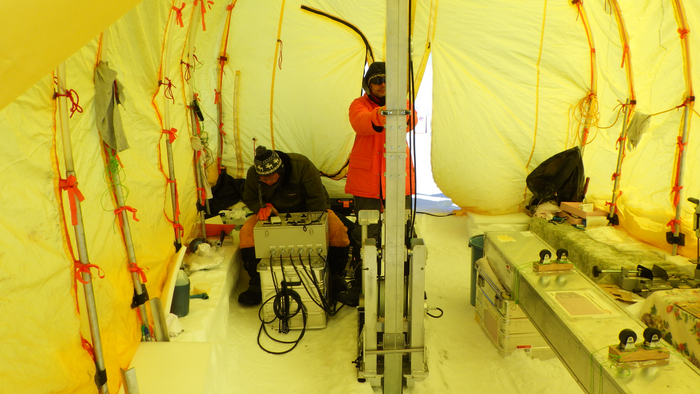Data stored in ice cores dating back 55 years bring new insight into atmospheric levels of a molecule that can significantly affect weather and climate.

Credit: Sumito Matoba
Data stored in ice cores dating back 55 years bring new insight into atmospheric levels of a molecule that can significantly affect weather and climate.
Dimethyl sulfide (C2H6S) is a small molecule released by phytoplankton in the ocean, which can play a big role in regulating the Earth’s climate. It encourages cloud formation above the sea, and is often called an ‘anti-greenhouse gas’, since clouds block radiation from the sun and lower sea surface temperatures. At least some blocked heat will be retained in the atmosphere, however, so the effects can be complex. Researchers at Hokkaido University have charted evidence for increasing dimethyl sulfide emissions linked to the retreat of sea ice from Greenland as the planet warms. They report their findings in the journal Communications Earth & Environment.
Modelling studies have long suggested that the decline in Arctic sea ice could lead to increased dimethyl sulfide emission, but direct evidence for this has been lacking. Assistant Professor Sumito Matoba and colleagues have inferred dimethyl sulfide levels over 55 years by quantifying the related compound, methane sulfonic acid (MSA), in ice core samples from the south-east Greenland ice sheet. MSA is directly produced from dimethyl sulfide, serving as a stable record of dimethyl sulfide levels. This process is part of a variety of chemical interactions among aerosols in the atmosphere.
The team, including researchers from Nagoya University and Japan’s Aerospace Exploration Agency, reconstructed the annual and seasonal MSA flux from 1960 to 2014, at a monthly resolution. The annual MSA levels decreased from 1960 to 2001, but then markedly increased after 2002.
“We found that July to September MSA fluxes were three to six times higher between 2002 and 2014 than between 1972 and 2001,” says Matoba. “We attribute this to the earlier retreat of sea ice in recent years.”
Supporting evidence comes from satellite data that has monitored the levels of the crucial sunlight-absorbing green pigment chlorophyll-a in the surrounding seas. The chlorophyll-a serves as an indicator of phytoplankton abundance, which in turn should correlate well with the amount of dimethyl sulfide released by the phytoplankton.
Arctic temperatures are rising twice as fast as the global average, and the summer seasonal sea ice extent has declined sharply in recent decades. This increases the amount of light striking the ocean and promotes the growth of phytoplankton.
While the latest results from the Hokkaido team add important confirmation of the changing dimethyl sulfide levels, Matoba emphasises that long-term and continuous monitoring of aerosols is needed. “This will be essential to follow the current impact, and predict future impacts, of dimethyl sulfide emissions on the global climate,” he says.
Journal
Communications Earth & Environment
DOI
10.1038/s43247-022-00661-w
Method of Research
Experimental study
Subject of Research
Not applicable
Article Title
Increased oceanic dimethyl sulfide emissions in areas of sea ice retreat inferred from a Greenland ice core
Article Publication Date
26-Dec-2022




